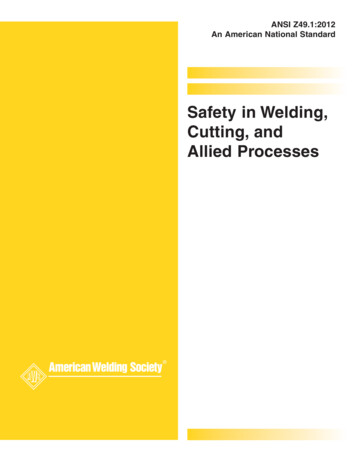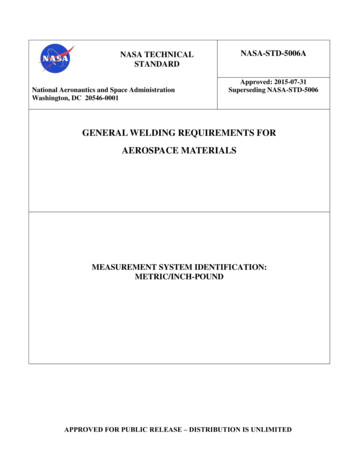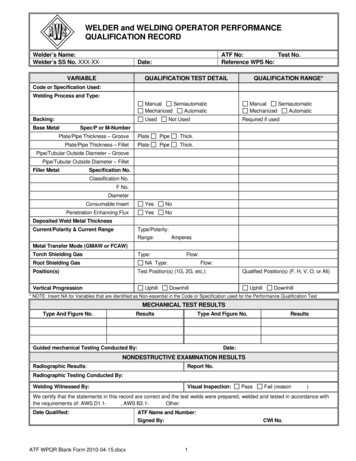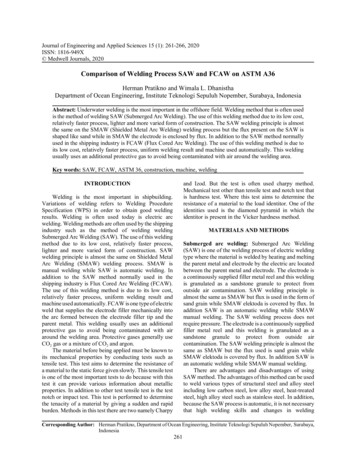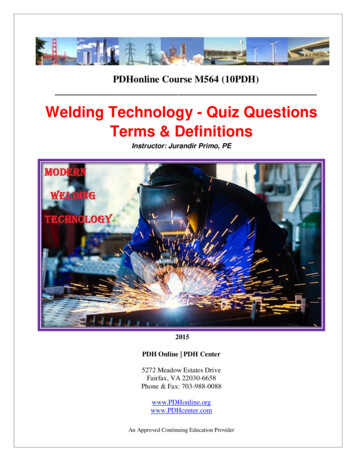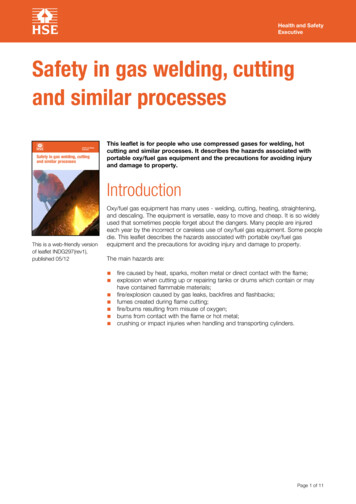
Transcription
Health and SafetyExecutiveSafety in gas welding, cuttingand similar processesSafety in gas welding, cuttingand similar processesSubheadsubhead run onThis leaflet is for people who use compressed gases for welding, hotcutting and similar processes. It describes the hazards associated withportable oxy/fuel gas equipment and the precautions for avoiding injuryand damage to property.IntroductionThis is a web-friendly versionof leaflet INDG297(rev1),published 05/12Oxy/fuel gas equipment has many uses - welding, cutting, heating, straightening,and descaling. The equipment is versatile, easy to move and cheap. It is so widelyused that sometimes people forget about the dangers. Many people are injuredeach year by the incorrect or careless use of oxy/fuel gas equipment. Some peopledie. This leaflet describes the hazards associated with portable oxy/fuel gasequipment and the precautions for avoiding injury and damage to property.The main hazards are: fire caused by heat, sparks, molten metal or direct contact with the flame; explosion when cutting up or repairing tanks or drums which contain or may have contained flammable materials;fire/explosion caused by gas leaks, backfires and flashbacks;fumes created during flame cutting;fire/burns resulting from misuse of oxygen;burns from contact with the flame or hot metal;crushing or impact injuries when handling and transporting cylinders.Page 1 of 11
Health and SafetyExecutiveFigure 1 Two cylindersSafety in gas welding, cutting and similar processesPage 2 of 11
Health and SafetyExecutivePreventing fire from heat, sparks,molten metal or direct contactwith flameThe flame from an oxy/fuel gas torch (often called a ‘blowpipe’) is a very powerfulsource of ignition. Careless use of oxy/fuel torches has caused many fires. Theflame will quickly set light to combustible material such as wood, paper, cardboard,textiles, rubber, and plastics. Many processes also generate sparks and hot spatterwhich can also ignite these materials.The following precautions will help prevent fire: move the workpiece to a safe location for carrying out hot work; remove nearby combustible materials (such as flammable liquids, wood, paper, textiles, packaging or plastics);protect nearby combustible materials that cannot be moved. Use suitableguards or covers such as metal sheeting, mineral fibre boards or fire-retardantblankets;check that there are no combustible materials hidden behind walls or inpartitions, particularly if the welding or cutting will go on for some time. Somewall panels contain flammable insulation materials, eg polystyrene;use flame-resistant sheets or covers to prevent hot particles passing throughopenings in floors and walls (doorways, windows, cable runs, etc);if the consequences of a fire are severe, eg work inside ships, you may need toappoint a fire watch during and after the work finishes. It is normal to maintainfire watch for 30 minutes after hot work finishes;prevent flame, heat, sparks or hot spatter from landing on the hoses;keep fire extinguishers nearby.Safety in gas welding, cutting and similar processesPage 3 of 11
Health and SafetyExecutiveExplosion when cutting up orrepairing tanks, drums and tyresFigure 2 Cutting up scrapIf a welding blowpipe or burner is used on a tank or drum containing flammablematerial (solid, liquid or vapour), it can explode. Such explosions have killed people.As well as flammable liquids such as petrol, diesel and fuel oil, substances such aspaints, glue, anti-freeze and cleaning agents may also release flammable vapours.Tanks and drums that are ‘empty’ usually still have residues in the bottom, and inseams and crevices. Just a teaspoon of flammable liquid in a drum can be enoughto cause an explosion. Never use an oxy/fuel gas blowpipe on a drum or tank that has contained, ormay have contained, flammable material, unless you know it is safe. It may besafer for a specialist company to carry out the work. If in doubt, ask.HSE has specific guidance on cleaning and inerting drums and tanks for hot work.TyresThe heat from hot work can generate flammable vapour from any oil or flammableresidue on the inner rim of the wheel. The rubber itself can degrade when heatedand release flammable materials. This vapour, confined by the tyre can cause anexplosion. These explosions are very violent and can kill. Avoid welding or flame cutting on wheels which have tyres fitted, even if the tyre is deflated.If you can’t remove the tyre, use cold cutting methods, eg a saw or hydraulicshears.Safety in gas welding, cutting and similar processesPage 4 of 11
Health and SafetyExecutiveFire/explosion causedby gas leaksAcetylene, LPG and other fuel gases are highly flammable, and form explosivemixtures with air and oxygen. Even small leaks can cause a flash fire or explosion,particularly if they are leaking into a poorly ventilated room or confined space wherethe gases can accumulate.Gas leaks are often the result of damaged or poorly maintained equipment, poorconnections or not closing valves properly after use.The following precautions will help to prevent leaks: turn the gas supply off at the cylinder when the job is finished or before the cylinders are moved or transported;isolate and purge or remove hoses and equipment from enclosed or poorlyventilated spaces when there is a break in work;keep hoses away from sharp edges and abrasive surfaces or where vehiclescan run over them;do not allow hot metal or spatter to fall on hoses;maintain all equipment and regularly check its condition.Checking for leaksRegularly check all connections and equipment for faults and leaks. Equipmentused in aggressive conditions such as demolition work or heavy engineering willnormally need more frequent checks, eg weekly. Use a proprietary leak detecting spray or solution suitable for use with oxy/fuel systems. Do not use soapy water or solutions containing grease or oils onoxygen systems.Never look for gas leaks with a naked flame.Immediately repair or replace leaking components.Leaking hoses should not be repaired, but they can be shortened to remove adamaged section. Refit hose tails using crimp clips designed for that task. Screwtightened crimps (jubilee clips) are not recommended. There is a risk of leaks due toovertightening or undertightening them.If a cylinder leaks when the valve is closedIf it is safe to do so, move the cylinder outside and away from sources of ignition(naked flames, sparks, electric motors, etc). Prevent unauthorised access and notifythe cylinder supplier immediately.Safety in gas welding, cutting and similar processesPage 5 of 11
Health and SafetyExecutiveBackfires and flashbacksBackfiresA backfire is when the flame burns back into the torch, often with a sharp bang.This may happen when the torch is held too close to the workpiece, or if the nozzleis partly blocked. The flame may go out or it may reignite at the nozzle. Sometimesthe flame burns back into the torch, and burning continues inside it. Backfires donot usually cause injury or damage, but they can indicate a fault in the equipment.If a backfire does occur: shut off the torch valves, oxygen first (usually coloured blue) and then the fuel gas (usually coloured red);shut off the oxygen and fuel gas cylinder valves;cool the blowpipe with water if necessary;check the equipment for damage or faults, particularly the nozzle.FlashbacksFlashbacks are commonly caused by a reverse flow of oxygen into the fuel gashose (or fuel into the oxygen hose), producing an explosive mixture within the hose.The flame can then burn back through the torch, into the hose and may even reachthe regulator and the cylinder. Flashbacks can result in damage or destruction ofequipment, and could even cause the cylinder to explode.Figure 3 Spark ignitorThe following precautions will help to prevent flashbacks: Use the correct lighting-up procedure. Purge the hoses before lighting the torch to remove any potentially explosive gas mixtures. Use a spark igniter and lightthe gas quickly after turning it on.Make sure the blowpipe is fitted with spring-loaded non-return valves.Use the correct gas pressures and nozzle size for the job.Maintain the equipment in good condition.These measures will reduce the risk of a flashback but will not completely eliminateit. Non-return valves will not stop a flashback once it has occurred.Safety in gas welding, cutting and similar processesPage 6 of 11
Health and SafetyExecutiveProtecting cylinders from flashbacksFit flashback arresters to both the oxygen and fuel gas hoses near to theregulators. For long lengths of hose, fit arresters on both the torch and theregulator.The fitting of a flashback arrester is not a substitute for safe working practice.If a flashback does occur: if it is safe to do so, close the cylinder valves on both fuel gas and oxygen; if the fire cannot be put out at once, evacuate the area and call the emergencyfire services.After a flashback, carefully check for damage to the torch, hoses, regulators,flashback arresters and other components. Replace parts if you need to. If indoubt, consult your supplier.Acetylene cylindersYou should pay particular attention to any acetylene cylinder which has beeninvolved in a flashback or affected by fire. There is a risk that the acetylene couldstart to decompose, and the cylinder could explode. If an acetylene cylinderbecomes hot or starts to vibrate, you must evacuate immediately and call theemergency fire services.Fumes created during flamecuttingThe fume from welding and flame cutting metals is harmful. You may need fumeextraction and/or filtering respirators (respiratory protective equipment or RPE) toreduce the risk of ill health.Figure 4 Visor and RPEDirt, grease and other contamination increases the amount of fume generatedand can introduce very toxic substances to it. Hot work on items with lead paint,chromium (chromate) paint or cadmium plating is particularly hazardous.Safety in gas welding, cutting and similar processesPage 7 of 11
Health and SafetyExecutive If you flame cut outdoors and the metal is clean and unpainted you will not normally need RPE. Try to work in a position where the wind blows the fumecloud away from you and other people.If you flame cut indoors or in conditions were there is little air movement, theneed for extraction and/or RPE depends on how much cutting you are going todo.Automated flame cutting machines, particularly multi-head machines, willnormally need fume extraction fitted to them.Work on materials coated with lead or chromate paints, galvanised or cadmiumplated or metal contaminated with oil, grease etc are likely to require fumecontrol such as extraction and/or RPE.HSE’s website has further detailed guidance on how to protect yourself fromwelding and cutting fume (see ‘Want to know more?’).Fire/burns from misuseof oxygenOxygen leaks also increase the fire risk. Clothing contaminated with oxygen, evenfire-retardant clothing, will catch fire easily and burn very fiercely. Oxygen can causeexplosions if used with incompatible materials. In particular, oxygen reactsexplosively with oil and grease.You must take the following precautions: never use oxygen to blow dust off clothing; never attempt to improve air quality inside confined spaces by releasing oxygen in the space;never allow oil or grease to come into contact with oxygen valves or cylinderfittings;only use equipment designed for use with oxygen. In particular, check that theregulator is safe for oxygen and for the cylinder pressure.Contact burnsThe following precautions will help to prevent burns from contact with the flame,hot metal, sparks and molten slag: work in a safe location away from other people; wear protective clothing, boots, gauntlets and eye protection; shut off the torch when not in use. Do not leave a lighted torch on a bench or the floor as the force of the flame may cause it to move;clamp the workpiece, avoid holding it by hand.Safety in gas welding, cutting and similar processesPage 8 of 11
Health and SafetyExecutiveCrushing or impact injuryThe following precautions will help prevent injury when handling and transportingcylinders. Prevent cylinders from falling or being knocked over by securing them with a stout chain or strap. It is normal to chain them to a wheeled trolley or against awall.Avoid moving a cylinder by tilting it on its base and rolling it. It is better to use atrolley.If transported in a road vehicle, the cylinders should be secured so they don’tcome loose in an accident.TrainingOxy/fuel equipment is relatively easy to use but users may still need someinstruction or training in: the safe use of the equipment, including the correct methods to purge, light and shut down;general safe working practices and the precautions to take;when and how to use the fire extinguishers;information about escape routes, how to raise the fire alarm and emergencyprocedures.Permit-to-workThe potential for injury and property damage are such that many companies wantto control hot work very closely. One way to achieve this is to operate a writtenpermit system for welding and flame cutting work. Sometimes called hot workpermits, they aim to ensure that welding and flame cutting does not start until afterthe risks for that particular task are identified and measures to eliminate or controlrisk are in place. A permit should specify: what work will be done;how and when it is to be done;what safety and health precautions are needed;who is responsible for checking it is safe to start;who will check the work is done safely;who is responsible for confirming that work is complete and there is no longer arisk from, or to, the people doing the work.Safety in gas welding, cutting and similar processesPage 9 of 11
Health and SafetyExecutivePreventing fire or explosion whenstoring and transporting cylindersSmall leaks may not be detected immediately. If they leak into a poorly ventilatedroom, a van or confined space, a dangerous concentration of gas may accumulate.To prevent gas accumulating: close the cylinder valves when the equipment is not in use;always provide adequate ventilation during welding and cutting operations;store gas cylinders outside whenever possible, or in a well-ventilated place;avoid taking gas cylinders into poorly ventilated rooms or confined spaces.Figure 5 Cylinder headThe most important safety measure when transporting cylinders in vehicles is toclose the cylinder valve. It is preferable to carry cylinders in an open-backed,pick-up style van. Fitting cages to the load bed may help prevent theft of theequipment. If cylinders are carried in enclosed load spaces then there should beadditional ventilation fitted. Cabin ventilation is not sufficient. For further guidanceon carriage of oxy/fuel cylinders see the HSE welding web pages.Safety in gas welding, cutting and similar processesPage 10 of 11
Health and SafetyExecutiveWant to know more?More detailed advice is available in the following web pages and publications:HSE welding web pages (www.hse.gov.uk/welding/)The safe use of compressed gases in welding flame cutting and allied processesHSG139 HSE Books 1997 ISBN 978 0 7176 0680 1www.hse.gov.uk/pubns/books/hsg139.htmHot work on small tanks and drums Leaflet INDG314 HSE Books 2000(Priced pack ISBN 978 0 7176 1766 1) www.hse.gov.uk/pubns/indg314.htmThe cleaning and gas freeing of tanks containing flammable residuesChemical Safety Guidance Note CS15 HSE Books 1985ISBN 978 0 1188 3518 3 www.hse.gov.uk/pubns/cs15.htmTake care with oxygen: Fire and explosion hazards in the use of oxygenLeaflet HSE8REV2 HSE Books 2007 www.hse.gov.uk/pubns/hse8.htmThe British Compressed Gases Association publish a range of useful documentsincluding example risk assessments, free guidance leaflets and technical booklets.See their website (www.bcga.co.uk/preview/publications.php).Further informationFor information about health and safety, or to report inconsistencies or inaccuraciesin this guidance, visit www.hse.gov.uk/. You can view HSE guidance online andorder priced publications from the website. HSE priced publications are alsoavailable from bookshops.This leaflet contains notes on good practice which are not compulsory butwhich you may find helpful in considering what you need to do.This leaflet is available in priced packs from HSE Books, ISBN 978 0 7176 6513 6.A web version can be found at: www.hse.gov.uk/pubns/indg297.pdf. Crown copyright If you wish to reuse this information visit www.hse.gov.uk/copyright.htm for details. First published 05/12.Published by the Health and Safety Executive05/12INDG297Page 11 of 11
Page 1 of 11 This is a web-friendly version of leaflet INDG297(rev1), published 05/12 Safety in gas welding, cutting and similar processes Subhead


